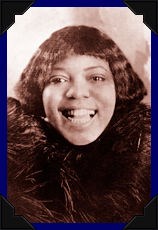
Born on April 15, 1894, in Chattanooga, Tennessee, Bessie Smith was one of ten children. Both of her parents had died by her eighth birthday, and she was raised by her older sister Viola and encouraged to sing and dance by her oldest brother Clarence. He soon joined the Moses Stokes traveling show, leaving Smith and their brother Andrew to sing for pennies on Chattanooga street corners.
Clarence later arranged an audition for Smith with the Moses Stokes Company and she was hired as a dancer in 1912. She became friends with an older Moses Stokes veteran, Gertrude "Ma" Rainey, who was called the Mother of the Blues and likely exercised some influence over the young singer. Smith had her own voice, however, and owed her success to no one. Her heavy, throaty vocals were balanced by a delightful sense of timing. Her live shows were a blend of comedy and drama in song. Smith was popular in Philadelphia, New York, and Baltimore, but she was beloved in the South. In 1923, her vaudeville touring led her to Memphis, where she played packed houses at the Palace Theater on Beale Street.
On February 16, 1923, Smith recorded "Gulf Coast Blues" and "Down Hearted Blues," accompanied by Clarence Williams on piano. Although recorded by Memphis singer Alberta Hunter a year before, Smith's "Down Hearted Blues" sold more than 780,000 copies in six months. Her sales made her a blues star on par with Mamie Smith (no relation), a vaudeville singer who had ignited the race records market with her 1920 recording "Crazy Blues."
Although Smith recorded extensively for Columbia - nearly 160 songs between 1923 and her last session in 1933 - her live performances were equally successful. During the 1920s she commanded fees of $2,000 a week and played sold-out theaters across the South, North, and Midwest. Her stage success influenced women blues singers like Memphis Minnie, but male blues singers like Leadbelly, who only heard her on record, emulated her too. She recorded with the best jazz sidemen, including pianists Fletcher Henderson and James P. Johnson, clarinetists Benny Goodman and Buster Bailey, guitarist Eddie Lang, saxophonists Coleman Hawkins and Don Redman, and cornetist Louis Armstrong. In May 1925, she made the first electronically recorded record, "Cake Walking Babies," by singing into the newly invented microphone.
During the Depression of the 1930s, Smith's drawing power in the large cities of the North and Midwest began to wane, but she remained popular in small towns and throughout the South. Furry Lewis proudly recalled playing with Smith in Chicago during the 1930s. She even made an early movie when W.C. Handy asked her to play the lead in a short film called "St. Louis Blues" loosely based on his song. On Sept. 26, 1937, after finishing a performance in Memphis, Smith and her manager were driving south on Highway 61, north of the Crossroads in Clarksdale, Mississippi, when their car struck an oncoming truck. The crash nearly severed Smith's right arm. She was taken to G.T. Thomas Hospital (now the Riverside Hotel) in Clarksdale where she died the following morning.
Bessie Smith is buried in Mount Lawn Cemetery in Sharon Hill, Pennsylvania.
Music Samples
Last updated: October 27, 2017
